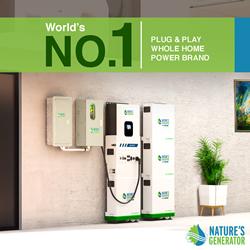Proving the Future of Interconnection: Nexamp’s Self-Performance Approach Delivers Results in Three Pilot Projects
Self-Performance proven to provide greater visibility and control, speeding completion and reducing project costs
July 24, 2025 - In what should be a model across the U.S., Nexamp has successfully completed construction on three projects, including the scope of work typically performed by the electric utility, marking a significant advancement in clean energy deployment. The concept, known as self-performance, allows developers to perform certain grid modifications and infrastructure upgrades to reduce both the time and cost required to connect their projects to the grid.
Working with Central Maine Power (CMP) in Maine and National Grid in Massachusetts, Nexamp took responsibility for procuring the necessary equipment and performing the requisite construction to get three recent projects completed and operating faster. Nexamp and its contractors worked closely with engineers and project managers from CMP and National Grid on each project, ensuring that all technical specs and requirements were met to maintain the utmost attention to safety and reliability.
The first three projects that were part of the self-performance initiative are:
• Hartland Solar, a 1.2 MW DC solar farm in Hartland, Maine
• Barre Road Solar, a 1.3 MW DC solar farm in New Braintree, Mass.
• Summit Farm Solar, a 2.6 MW DC solar farm in New Braintree, Mass.
"Self-performance allows us to take much greater control over the interconnection procurement and construction, enabling us to bring projects online faster and closer to budget," notes Daniel Passarello, Lead Consulting Engineer, Grid Integration, Nexamp. "By leveraging our construction contractor relationships, we can move much of the interconnection work along in parallel to the build-out of the solar farm rather than having to treat them as separate processes. This ultimately creates opportunities to reduce the number of mobilizations."
During the self-performance process, Nexamp is able to directly negotiate better pricing and delivery times with its long-standing supplier relationships. Passarello notes that the company orders much of the same utility-required hardware for its own facility in bulk, and if an expedited shipment is needed, the company can go to the supplier directly. "The results are greater visibility, control, and certainty to drive shorter interconnection timelines, create opportunities to save costs, and reduce burden on utilities. This kind of forward thinking makes the continued deployment of clean energy more efficient, leading to lower costs for consumers and increased energy supply to meet our nation's growing demand," he says.
Utilities have historically maintained responsibility for construction required to connect a distributed solar project to the grid. With the rapid increase in solar generating capacity, sharing some of that work with private developers is proving to be a benefit.
The Solar Energy Industries Association (SEIA) estimates that nearly 8 Gigawatts of community solar have been installed in the U.S. through the end of 2024, and that number is increasing rapidly, expected to almost double in the next five years. Finding ways to ensure that these projects are deployed quickly and efficiently is critical, and the organization notes that self-performance is critical to future success.
"We must modernize and streamline the interconnection process to keep pace with fast-growing demand for energy," said SEIA's Vice President of State Affairs, Sara Birmingham. "Self-performance is one of several innovative approaches that can accelerate project timelines and lower costs, which benefits all ratepayers. SEIA congratulates Nexamp for taking this leap and looks forward to collaborating across the industry on solutions to deploy solar faster, strengthen grid reliability, and improve energy affordability for all Americans."
In addition to demonstrating the promise of a self-performance program, Nexamp also recently worked with the Solar and Storage Industries Institute (SI2) on a report detailing the important role flexible interconnection plays in getting projects connected more quickly and with fewer required grid upgrades. Flexible interconnection allows distributed solar projects to interconnect to the grid and perform to accommodate grid capacity dynamics, rather than requiring the developer to spend significant sums of money to build additional capacity. Together, these two shifts can significantly improve two of the biggest hurdles to swift deployment: interconnection timelines and costs. This initiative shows that some of today's challenges for distributed solar, such as cost and deployment times, can be addressed with innovative and collaborative solutions.
"The opportunity to lead some of the very first self-performance projects is significant and we're proud to see the results. CMP and National Grid are each showing the market how adaptability and process improvements make a difference in getting more renewable energy resources onto the grid. Customers in Maine and Massachusetts are the real beneficiaries of these three projects today, as they now are able to join tens of thousands of other Nexamp community solar subscribers in saving money and supporting the expansion of clean energy," added Nicholas Burica, Sr. Director of Grid Planning, Nexamp.
About Nexamp
Nexamp is transforming the new energy economy with proven solar and storage solutions, and inviting individuals, communities, and businesses to take part in the benefits. Our end-to-end capabilities—including project development and acquisition, design, construction, and operations—position Nexamp as a just and equitable market leader. By building integrated clean energy products, we ensure that both savings and job opportunities reach everyday Americans. With more than 1 GW of renewable energy-generating assets currently in operation and several more gigawatts under construction or in development, we're building a cleaner and more resilient future. Visit us at www.nexamp.com.
Featured Product

